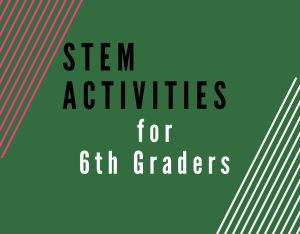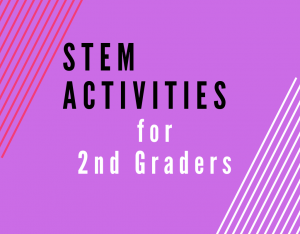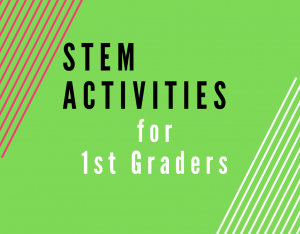STEM activities for third graders may be challenging to come across, usually because most are self-described as being geared towards at least two other grades. When aligned with what students are currently learning, STEM activities can tremendously boost knowledge and understanding of concepts.
To be effective and engaging, STEM activities should integrate STEM subjects while students have fun doing them. Sometimes, students won’t even realize that they are learning, but the knowledge will stick with them for a long time. I chose these activities because they combine and teach multiple STEM subjects that are naturally used together while aligning with third-grade level Next Generation Science Standards (NGSS). And not to mention, they are all fun and exciting!
Table of Contents
Seed Socks
Materials
- Plastic bag
- Soil
- Shoebox
- Scissors
- Socks
Description
This STEM activity revolves around the context of an animal’s role in dispersing seeds. It gives third graders a better idea of the kinds of plants growing in their area and helps them begin to think about the evolutionary strategies of plants.
The first step requires walking around different types of fields wearing socks. This can be done as a class field trip or by having students do it over the weekend with adult supervision, making sure there aren’t any sharp objects to step on.
When the students come back to the classroom with their socks, they can examine the different types of seeds they have picked up. They may notice the differences between each students’ socks based on the plants growing on the kind of field they walked around.
The third step is to cut the sock open and cut off the parts of the sock without seeds. Get a shoebox lined with a plastic bag and put some potting soil in it. Have the students place their seed sock (seeds facing up) on top then put a thin layer of soil over it. Water over them, set them aside where they have access to sunlight, then water them throughout the days like a normal plant.
In about a week, the seeds should begin to sprout.
STEM Science Content
This activity aligns with NGSS MS-LS1.B.3: “Plants reproduce in a variety of ways, sometimes depending on animal behavior and specialized features for reproduction.” Additionally, you may want to conduct an experiment to determine the best conditions for plant growth by varying the amounts of light and water for each sock. Organize the information through graphs or writing it down then let students analyze the results.
Engineering Content
Upon discussion, students may realize that they have engineered a way to mimic animals spreading seeds. If you want to take it an extra step further, you may want to allow them to design and build their own seed sock planting structure that will expose it to light and will enable them to efficiently water without making a mess.
What to Say and Ask
- What seasons of the year do you think it would be best to do this activity? Why?
- What kind of weather might be best for this activity? Why is that?
- What makes the seeds to stick to the sock?
- Why do some seeds stick better than others?
- How do you think the ability to stick “helps” the plant?
Source
“Sock Seeds.” PBS LearningMedia, Zoom, 22 Nov. 2019, https://ny.pbslearningmedia.org/resource/tdc02.sci.life.stru.sockseeds/sock-seeds/.
Racing Spools
Materials
- Tape
- Rubber bands, assorted thickness
- Metal washers
- Pencils
- Toothpicks
- Spools
Description
When we think about energy, we usually think of movement and action. But, energy can be stored in objects that aren’t moving as well.
The first step is to put a rubber band through the spool and a toothpick through one side of the hoop to keep it in place. Break off the ends of the toothpick, so they’re not sticking out over the sides of the spool then put tape over it.
Next, pull out the rubber band on the other side and place a washer over it to stay against the spool. This will make things smoother.
The third step is to put a pencil under the rubber band hoop and wrap it around once or twice. Wind the pencil around a couple of times, place it on a long table or floor, let go and watch it zoom away.
STEM Science Content
This STEM activity for third graders aligns with NGSS 4-PS3-4: “Apply scientific ideas to design, test, and refine a device that converts energy from one form to another” and NGSS 4-PS3-1: “Use evidence to construct an explanation relating the speed of an object to the energy of that object.”
To be able to move, vehicles must overcome the forces that keep them in place, particularly gravity and friction. They do this by generating forces of their own, pulling or pushing against the forces that resist their motion.
Energy can be stored and all objects have the capacity to do so. For example, batteries are designed to store electrical energy and can be tapped on by a flick of a switch. Even placing a pencil on a desk increases its potential energy. If the desk were to fall over, the stored energy would be turned into kinetic energy, the energy of motion.
There are different types of energy. The pencil on a desk or a rock sitting on a hilltop holds what scientists call gravitational potential energy. The bonds that hold fuel atoms together store chemical potential energy. The rubber band that powers the racing spool in this activity stores the energy required to stretch it or wind it up. This is what scientists call elastic potential energy. When the rubber band is released, it returns to its natural state, converting the stored energy into kinetic energy used to drive the vehicle forward.
STEM Engineering Content
To get students to put their engineering hats on, you may suggest for them to change a variable and retest their design. Engineering includes defining a problem and providing solutions. A variation of this activity is to keep the washers hidden away at first. The children may notice their racing spools fumbling around. Bring out the washers among an assortment of materials then ask what they can use to make their racing spools smoother. They may then notice that their racing spools drift towards one side so they would put pencils and washers on both sides. Some third graders may have trouble figuring out how to wind it up this way, but once they do, they will notice their racing spools go straighter.
What to Say and Ask
- In this activity, what is the role of the rubber band?
- Why does the rubber band help make the spool go?
- Use the terms kinetic energy and potential energy to describe the spool racer.
- What do you think would happen if you put a pencil on each side?
- How can we make sure the race is fair?
- If you were to build one, how might you redesign it? Why would you do that?
- What changes would you make to allow the racing spool to go faster?
Source
“Potential and Kinetic Energy: Spool Racer.” PBS LearningMedia, Zoom, 28 Nov. 2019, https://ny.pbslearningmedia.org/resource/phy03.sci.phys.mfe.zsplcar/potential-and-kinetic-energy-spool-racer/#.XedU2R-YX0o.
Waterproof Roof
Materials
- 1 Sunday newspaper
- Cardboard
- Several rolls of tape
- Other materials of your choosing
- 100–500 craft sticks
- 100–500 straws
- 100 aluminum foil squares, 3″ x 3″
- Fabric scraps
- Leaves
- 1 roll paper towels
- Water
- Large, shallow plastic storage container or other basin (optional)
- Markers
- Scissors
- Spray bottle
Description
Imagine relaxing in your home on a rainy day. You might be watching Netflix or eating a meal when, all of a sudden, you hear drips of water. Your roof is leaking!
Roofing materials these days are engineered to last 20 to 30 years. Like most things that are engineered well, until something goes wrong, you probably don’t think about your roof too often. Most roofs today require no maintenance compared to roofs of the past.
Cut several 4″ x 6″ cardboard rectangle and 4″ x 4″ cardboard squares. Use these pieces to tape together several “houses.” Or, depending on how much time you have, you can allow the children to tape and design the houses themselves. To keep the activity area dry, you can test roofs in a large shallow plastic storage bin or outside.
Ask students to think about the various shapes and types of materials used in the roofs they see around the neighborhood. Have a discussion on how the shapes of roofs change to suit the climate. For example, flat roofs aren’t suitable for areas that receive a lot of snow because the snow can collapse the roof due to its weight.
Introduce the students to the design challenge. Explain how they are to develop a roofing system for their houses to prevent water from leaking in.
Give the students about 20 minutes to build their roof. Some children may choose to use one material while others may want to use multiple materials. Once they are satisfied with their roofs, they are to submit it for testing.
Test the roof.
- Place the house on a sheet of newspaper. Use the spray bottle to spray water on the roof.
- Lift the house and examine the newspaper for moisture.
- Find leaks then redesign. Repeat.
Evaluate the roof’s success.
- Did the roof prevent water from getting into the house?
- How much water got in if it did?
Science Content
If you dip one end of a paper towel in a cup of water for a few minutes, you will notice that the whole paper towel has become soaking wet. This is because of something called capillary action, also known as wicking. Wicking is when water or other liquids travel any direction through small tubes or openings, even against gravity. This is bad for buildings and houses because it makes it easier for water to get in. Water can wick from wet soil through a building’s concrete foundation and into the basement. Water can also wick from the smallest hole in a roof and drip into the attic. This makes it more difficult to protect a house or building from the effects of water and presents challenges to engineers who design buildings.
Engineering Content
Engineers who design roofs and the materials for them must take into account the climate in the area. For example, in an area where it rains a lot, an architectural engineer may want to design a sloping roof so rain would roll off rather than sit on top of the building. That is why roofs are sloped in most cold and wet areas. Architectural engineers may also want to make sure there are no openings for water to get through the roof and into the building.
On the other hand, a materials engineer is more concerned with what the roof is made of, so the roof can have rain roll right off rather than absorb it. A materials engineer would need a deep understanding of roofing materials that repel water, such as rubber, to do this. That’s why in most cold and wet climate areas, roofs have a combination of materials that work together to repel water and eliminate absorption.
What to Say and Ask
- If your team needed to make changes while building the roof, describe why you did.
- Do you think engineers ever have to make changes to their plans? If so, what effect would this have on their budget?
- If you could use materials that weren’t available to you for this activity, what would they be and why?
- What do you think was the best part of your design and why?
- If you had the chance to re-do this project, what would your team do differently?
- If your roof design were to be put on a real building, do you think it would require frequent maintenance? Why or why not?
Source
http://www.discovere.org/sites/default/files/Waterproof%20the%20Roof_082616.pdf



